The Lilith Blog
July 20, 2017 by Ali Walensky
Planned Parenthood Saved My Life. But the Story Doesn’t End There.
Hi. My name is Ali Walensky. On December 15th, 2016 I was diagnosed with stage 2B breast cancer. As of June 15th, 2017, I was declared cancer free. The Lilith article I’m featured in focuses on my advocacy for an incredible organization called Planned Parenthood. Planned Parenthood was the first place I went to for a breast exam. They also wrote all of my prescriptions for any tests I needed and checked in on me the day after I was diagnosed. It’s impossible for me to overstate how much Planned Parenthood has helped me and how they truly saved my life.
Most women my age aren’t too concerned about breast cancer. It’s usually something that affects women who are at least twice my age, but breast cancer is something that’s been on my mind for a while now. My family has a history of the BRCA 1 gene mutation. This mutation gives a person anywhere from a 65-89% chance of developing breast and ovarian cancer as well as a higher chance of other cancers such as skin and pancreatic. My mother, her two sisters, my first cousin, and (as I would come to find out) my sister and I all have this mutation. Not only that, but my grandmother and her two sisters, who were all BRCA negative, are all breast cancer survivors. Ashkenazi Jewish women are also at a higher risk of developing breast cancer. I knew and accepted the fact that it would happen to me some day, I just didn’t think it would be so soon.
From January to April of this year I had six chemotherapy infusions. If the side effects of chemo weren’t enough to deal with, I had a decision weighing on my mind: surgery. My options were a lumpectomy with radiation afterwards, a unilateral mastectomy, or a bilateral mastectomy. Many people in my life thought my decision would be easy. Get the bilateral and then you don’t have to worry about a reoccurrence or continue to get screened. With my genes and luck cancer was bound to happen again. But let’s back up for a second. I’m 25 years old. Opting to get my breasts cut off, breasts that I’ve had for fifteen years and proudly grew myself, is not a simple decision for me. There is a trend now of young BRCA+ women opting for a double mastectomy before they’re diagnosed to make sure they don’t develop breast cancer. They have every right to make that decision if they feel that’s the best option for them. But this is the problem that I kept coming back to: Even without breast tissue a person still has a 1-3% chance of developing breast cancer. I had a big decision to make.
- No Comments
July 20, 2017 by Eden Gordon
Cannibal Mermaids, Dybbuks, Golems, and Lilith Herself: Feminist Retellings of Jewish Folktales
I saw the Polish film “The Lure” in the West Village a few months ago. The story riffs on The Little Mermaid in a very unexpected way. Ariel is no longer a fork-wielding dilettante, but instead has morphed into two sharp-fanged, angel-voiced, flesh-eating mermaids, who sing, dance, and devour their way through Communist Poland’s underground nightclub scene.
I often find myself thinking about types of feminist reclamation, both the kind that equips traditionally submissive women with sharp fangs and the kind that turns sharp-fanged monsters into powerful protagonists. These reclamations are not always completely triumphant. After all, the fundamental nature of a “reclamation” is that something must be re-made: essentially, changed. Still, having feminist retellings is far better than leaving the stories in their original forms, where the woman’s voice is often left out entirely.
Aside from Lilith, one of the central Jewish folkloric figures reclaimed by feminists is, surprisingly, the dybbuk. Traditionally, this creature was a formless ghost who possessed women and was often blamed for their “hysteria.” It rose to prominence throughout the Jewish Diaspora, popularized among the Eastern European Jews in folk rituals and literature. S. Ansky’s play “The Dybbuk,” or “Between Two Worlds,” which had its Yiddish-language premier in Warsaw in 1920, tells of a woman possessed by her dead suitor’s spirit; the play has been lauded as a nostalgic portrayal of disappearing shtetl life. Its voiceless heroine, Leah, dies at the end, consumed by the spirit within her. It’s the story of a female whose body is possessed by a masculine spirit, and about the often violent subjugation of the female voice. But it’s more a blunt depiction of the problem than a triumphant feminist redemption.
- No Comments
July 18, 2017 by Robin Nafshi
Losing God in Jerusalem
 While living in Jerusalem, I lost God. I never lost the belief in God, mind you, but rather, God’s presence. And that is far more unsettling.
While living in Jerusalem, I lost God. I never lost the belief in God, mind you, but rather, God’s presence. And that is far more unsettling.
I would wander the streets of the most intensely spiritual city in which I had ever lived, searching. I shunned the obvious places—the hip-happening shuls, the austere Western Wall, and even the sanctuary of my own seminary. God, the still small voice that usually rested in my soul, would not be in any of those spots. I had to pursue the less obvious.
I sought out Hadaya. His small shop in the below ground part of the Cardo had room for two folding chairs and small table with a pitcher of water and two plastic cups—but almost no space for his wares. Hadaya was a jeweler who made, among other items, a special ring engraved with the words gam zeh ya-avor, “this, too, shall pass.” When buying one of these rings, Hadaya would tell the story of King Solomon and his most trusted servant, Benaiah. The King sent Benaiah to find a ring that would make a sad person happy and a happy person more subdued. Benaiah wandered the earth, searching and searching. He never found the ring, and instead had one made with the words, gam zeh ya-avor. It did exactly what the King had requested. Hadaya made me his special ring, with a small ruby. As I had it done on a Friday, Hadaya added to the inside of the ring’s band an engraving of the Jerusalem skyline.
Which brings me back to that City and my searching. The ring brought me hope and possibility. But it didn’t bring me God.
I went to parks on Shabbat mornings to watch dogs fetch tossed balls and to hear children squeal when the dogs returned. Sometimes, the children fetched the balls and the dogs squealed when the children returned. Returned. The dogs came back. So did the children. Why couldn’t God?
- 2 Comments
July 14, 2017 by Eden Gordon
This Website Helps Progressive Female Candidates Run for Office
Eliza Cussen was on her way to see “Wonder Woman”, and listening to an episode of her favorite podcast, “Call Your Girlfriend.” This one focused on women in politics (or the lack thereof). Like many would in this situation, she was wondering: what can I do?
Right then, she decided to create what is now Project Sheila, an organization dedicated to helping female politicians launch campaign websites. Cussen has been interested in web design for most of her life, and was working as a digital communications specialist when she had the idea. She saw that although she did not have significant funds to donate to campaigns, she could use her expertise to help in another way. She put out a call to friends in her network, asking if anyone needed help with web design, and received several requests right away. Around three weeks later, Project Sheila went live.
- No Comments
July 13, 2017 by Elana Sztokman
Stop Asking “Why Are You Still Orthodox?”
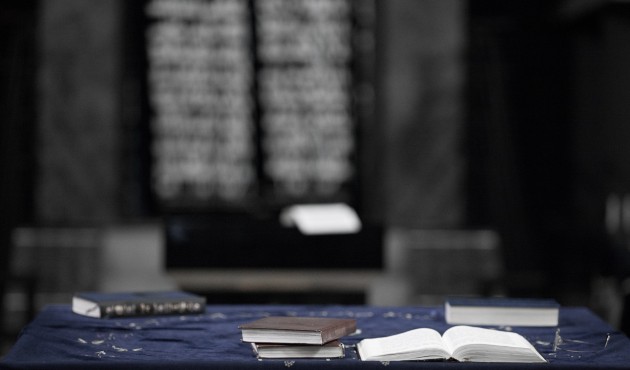 Recently, at the #HUC #HealingHatred conference, Shira ben Sasson Furstenburg gave a talk about the connection between religious extremism and sexism. She talked about how pretty much all major religions equate “more religious” with notions of control over women’s bodies. This is an idea that I talk and write about a lot, so I listened intently.
Recently, at the #HUC #HealingHatred conference, Shira ben Sasson Furstenburg gave a talk about the connection between religious extremism and sexism. She talked about how pretty much all major religions equate “more religious” with notions of control over women’s bodies. This is an idea that I talk and write about a lot, so I listened intently.
During the question and answer period, the very first question was addressed at her: Why are you then still Orthodox?
Before she responded, Shira said, “You realize that you are asking a very personal question, even though this panel was not a personal one.” She then proceeded to answer anyway, talking about the importance of fighting for change from “within”—a comment that drew applause.
- No Comments
July 10, 2017 by Rachel Braun
Embroidering a Jewish Life
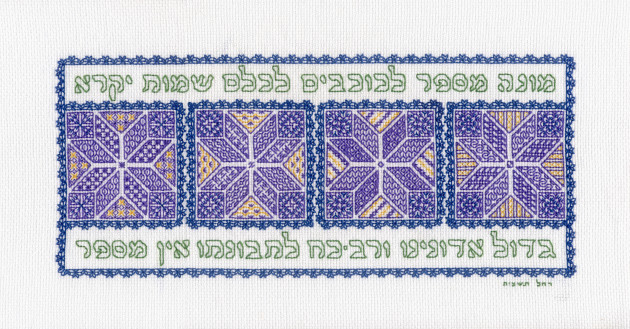
God Counts the Stars, 2015, Rachel Braun. Scan by Philip Bookman.
Embroidery has been part of my life for over two decades; it is a core Jewish practice for me and an entry point into sacred texts. I design Judaic embroidery, starting with words from Torah or liturgy, then elucidating and interpreting the words with needle and thread. But before I discovered my embroidery passion, I’d thought about needlecraft only in limited ways.
In college, some 40 years ago, I read an article about Colonial quilt-making for an anthropology class. The author wondered why Colonial women would commit to such a painstakingly slow production process. Indeed, needlecraft is very laborious! Designing and stitching an embroidery canvas can take me easily 150 hours.
The author’s hypothesis was that usually women were responsible for repetitive production processes which had temporary outcomes, living under a tyranny of iterative tasks. Women cooked and fed their families; hunger returned anew. We laundered clothing; those garments became soiled. We cleaned; dirt arose again in every corner. Quilting, the author concluded, allowed women to participate in permanent material culture, establishing and recording their presence. Perhaps not as physical as barn-raising (and not as well paid?), but still valued.
In my adult life, I’ve become aware of the impermanence of traditional female tasks, though my responses to the feeding-laundering-cleaning conundrums of Colonial women may have differed. Raising four children, I cycled through three basic lentil recipes at dinner and taught my kids to use the washing machine. As for cleaning, my mantra became “as long as the kids don’t get cholera, the house is clean enough.” They didn’t, and it was.
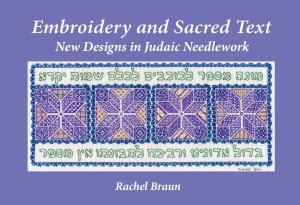 But I do embroider—vigorously, creatively, spiritually. Am I, as was alleged for our Colonial quilters, seeking immortality in material culture? That premise seems a bit specious: what we call women’s work (and what that treatise I read in college alleged was impermanent) is indeed permanent work: a long-term investment in the continuity and culture of humanity, as stabilizing as building a barn. But material culture has its purpose—useful, beautiful, necessary, communal. My framed embroidery pieces adorn the walls of my home and shul, and I dream that one day they will be passed to future descendants, or even considered museum-worthy. Just in case they aren’t, I’ve made a dive at immortality by sharing them in a book, Embroidery and Sacred Text (2017).
But I do embroider—vigorously, creatively, spiritually. Am I, as was alleged for our Colonial quilters, seeking immortality in material culture? That premise seems a bit specious: what we call women’s work (and what that treatise I read in college alleged was impermanent) is indeed permanent work: a long-term investment in the continuity and culture of humanity, as stabilizing as building a barn. But material culture has its purpose—useful, beautiful, necessary, communal. My framed embroidery pieces adorn the walls of my home and shul, and I dream that one day they will be passed to future descendants, or even considered museum-worthy. Just in case they aren’t, I’ve made a dive at immortality by sharing them in a book, Embroidery and Sacred Text (2017).
- 6 Comments
July 7, 2017 by Aileen Jacobson
“Marvin’s Room” Explores Sisterhood and Caregiving
 Why are women expected to be caregivers—for their children, their parents, and sometimes for other relatives as well—while men are not?
Why are women expected to be caregivers—for their children, their parents, and sometimes for other relatives as well—while men are not?
That is not the question being asked by “Marvin’s Room,” a 1990 play by Scott McPherson now making its Broadway debut in a beautifully calibrated and engrossing production. Nevertheless, the question may occur to women in the audience.
The comedic drama, directed by Anne Kauffman, explores the relationship between two sisters who became estranged some 20 years earlier, when one stayed home to care for their dying father and his ailing sister while the other departed to pursue different paths, eventually becoming a single mother of two boys and a candidate for a degree in cosmetology, which she hopes will lead to a more affluent and fulfilling life. After the caregiver discovers she herself has leukemia, she reaches out to her sister and nephews as possible bone marrow donors, and they come to visit. The story is told with a lot of wry, absurdist humor about such subjects as awkward doctor visits, painful backs and encounters with costumed actors at Disney World.
- No Comments
July 6, 2017 by Rebecca Katz
A Weighty Conversation
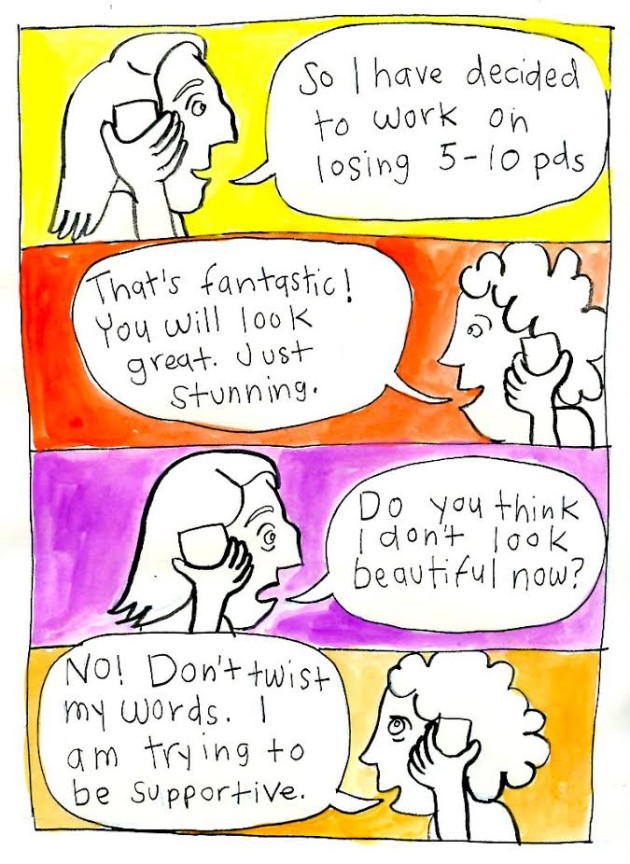

Rebecca Katz is your average white, Jewish, twenty-something who likes to talk and draw about food, privilege, television, and her period. After six years away, Rebecca has returned home to Brooklyn and lives just three blocks away from where she grew up. Take a look at more of her comics at katzcomics.tumblr.com.
The views and opinions expressed in this article are the author’s own and do not necessarily reflect those of Lilith Magazine.
- No Comments
July 5, 2017 by Simone Zelitch
Week Sixteen
 On Week Sixteen of my pregnancy, my husband and I were in the Neonatal Unit of Hahnemann. We were guardedly optimistic to the point where we’d decided we would tell his daughter later that week at Christmas, and had even given the baby a name: Charlotte if it’s a girl, or David if it’s a boy. I’d figured this would be like the other ultrasounds that I’d been having regularly since conception, but it was Week Sixteen. It was a landmark.
On Week Sixteen of my pregnancy, my husband and I were in the Neonatal Unit of Hahnemann. We were guardedly optimistic to the point where we’d decided we would tell his daughter later that week at Christmas, and had even given the baby a name: Charlotte if it’s a girl, or David if it’s a boy. I’d figured this would be like the other ultrasounds that I’d been having regularly since conception, but it was Week Sixteen. It was a landmark.
I knew something was wrong when the technician wouldn’t tell us that everything was right. I saw the numbers: femurs in Week Fourteen range, lagging behind the body. It was not as stark a growth restriction as last time, and I tried not to let it get to me, but then she left the room to show the material to Dr. Wapner.
We sat in the darkened cubicle where the kid’s bottom was still on the monitor. A semi-circle of the light-weight curtain occasionally blew when people hurried by. I said to my husband, “I just hope he doesn’t bring the Death Nurse”. This was the nun-like woman who’d appeared with Dr. Wapner the day the blood-flow reversed with our first baby, Ella. We lost Ella two weeks later.
The technician returned to re-measure the femur, and some time after that Dr. Wapner himself came in. He articulated a few pleasantries, and scrunched up his face. “I’ll just say it.”
The growth was in the range of normal. What concerned him, really, was the blood flow. He wanted us back in two weeks. Then, he’d check growth and also get a more accurate Doppler reading.
Oh yeah. The Death Nurse was with him.
So where was I? I didn’t want to keep the ultrasound photos. That same afternoon, I said out loud, twice, “I guess if it doesn’t look good in two weeks, I’ll get an abortion.”
- 2 Comments
July 4, 2017 by Eleanor J. Bader
The Anthology Giving Voice to the Labor of Caregivers
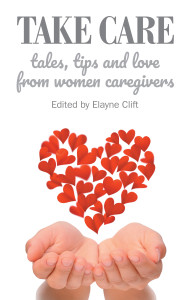 The numbers are mind-boggling: According to a 2015 report issued by the National Alliance for Caregiving and AARP, 39.8 million Americans—the lion’s share of them female—are providing unpaid care for someone aged 50 or older. Another two million people—again, most of them women—work as paid in-home health aides, administering medication, cooking, shopping, and providing oversight and companionship for adults needing assistance.
The numbers are mind-boggling: According to a 2015 report issued by the National Alliance for Caregiving and AARP, 39.8 million Americans—the lion’s share of them female—are providing unpaid care for someone aged 50 or older. Another two million people—again, most of them women—work as paid in-home health aides, administering medication, cooking, shopping, and providing oversight and companionship for adults needing assistance.
Writer Elayne Clift’s latest anthology, Take Care: tales, tips and love from women caregivers (June 2017, braughlerbooks.com) provides a forum for caregivers to address what it means for them—as daughters, daughters-in-law, nieces, friends, wives, or grandchildren—to tend to elders and the sick. For most, it’s a labor of love, and as they outline both the joys and hardships of providing care, they are, for the most part, the epitome of grace under pressure. But that’s not to say that the job is easy.
Take Care is a slim volume—28 brief essays and poems—and while it touches numerous aspects of caregiving, it is not comprehensive. Instead, it movingly zeroes in on what it means to be there for someone else, whether for the long haul or for a shorter stint. Harvard professor Paula J. Caplan, calls the collection “a sorely needed jewel that helps and heals.”
Clift spoke to Eleanor J. Bader by telephone a few weeks ago, from her Vermont home.
- 3 Comments
 Please wait...
Please wait...